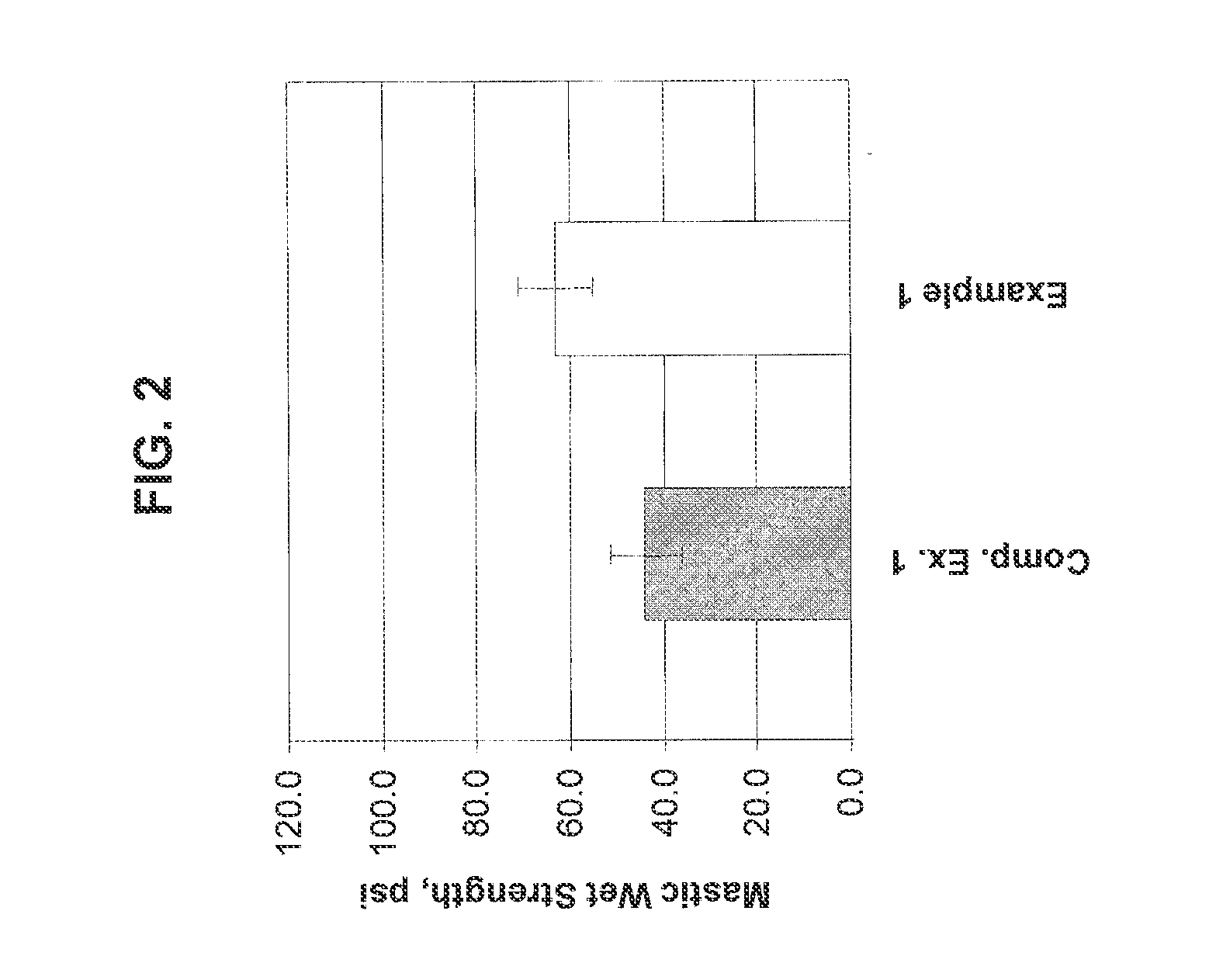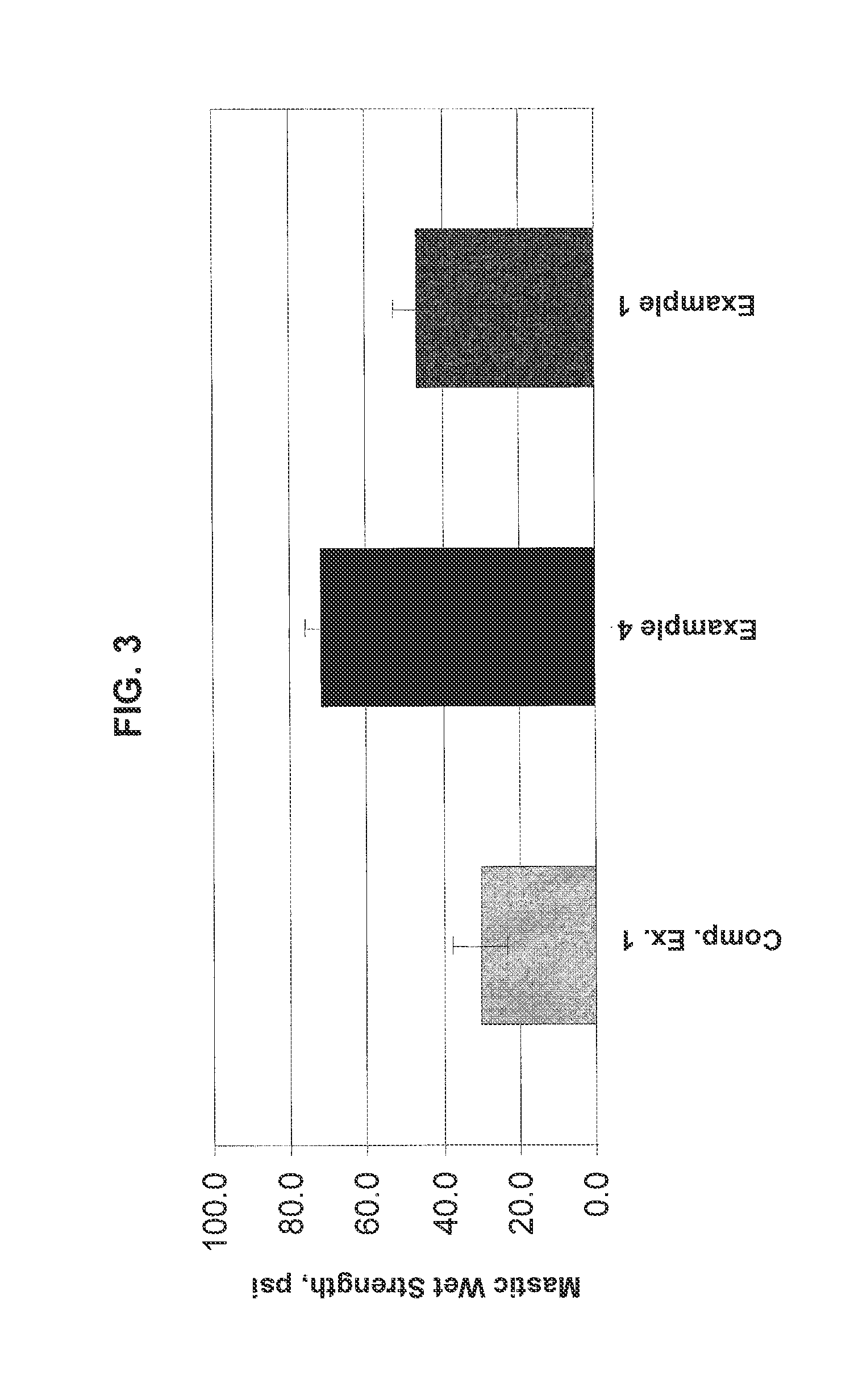Styrene-Acrylic-Based Binders and Methods of Preparing and Using Same
a technology of acrylic-based binders and styrene, which is applied in the direction of aldehyde/ketone condensation polymer adhesives, electrical equipment, synthetic resin layered products, etc., can solve the problems of reducing bonding capabilities and failure to meet required performance standards
- Summary
- Abstract
- Description
- Claims
- Application Information
AI Technical Summary
Benefits of technology
Problems solved by technology
Method used
Image
Examples
example 1
[0063]Example 1 was prepared using the procedure described for Comparative Example 1 except that the initiator solution was provided in an amount of 0.6 parts per hundred monomer. The resulting styrene-acrylic copolymer had a gel content in THF after 2 days of immersion of 61.0%.
examples 2-3
[0064]Example 2 was prepared in the same manner as Example 1 except by copolymerizing 0.9% acetoacetoxyethyl methacrylate (AAEM) based on the total weight of monomers with 53.05 parts by weight of styrene and 42.05 parts by weight of butyl acrylate. Example 3 was prepared in the same manner as Example 1 except by copolymerizing 1.8% AAEM based on the total weight of monomers with 52.6 parts by weight of styrene and 41.6 parts by weight of butyl acrylate.
[0065]Comparative Example 1 and Examples 1-3 were prepared as mastic formulations with a 12:1 filler to binder ratios as shown in Table 1 below:
TABLE 1IngredientsParts by weight1Polymer Dispersion*10.52Non-Ionic Surfactant0.183Defoamer0.14Water10.85Non-Ionic Surfactant0.86Pigment Disperser0.057Attapulgite Clay0.78Water7.89TEXANOL1.710Ethylene Glycol2.011Cellulose Ether Thickener0.612Alkali Swellable Thickener0.513Ammonium Hydroxide (26%)0.214Ground Calcium carbonate63.015Water (if needed)1.2Total100.0*Polymer dispersion contains 50% ...
examples 4-6
[0076]Example 4 was prepared in the manner described above for Example 1 except by copolymerizing 1.5% glycidyl methacrylate (GMA) based on the total weight of monomers in place of equal parts of styrene and butyl acrylate (i.e. 0.75% styrene and 0.75% butyl acrylate). Examples 5 and 6 were prepared in the manner described above for Example 1 except by copolymerizing 3% and 3.5% of GMA, respectively, in place of equal parts of styrene and butyl acrylate. Examples 4-6 were prepared as adhesives with 12:1 filler to binder ratios in the manner described above. The ANSI 136.1 Type I wet shear strengths of the adhesives were measured for Examples 1 and 4-6 and compared to Comparative Example 1 and are illustrated in FIGS. 3-4. As shown in FIGS. 3-4, the wet shear strengths of the adhesives containing GMA (Examples 4-6) improved as compared to the wet shear strength of the adhesives not containing GMA (Example 1 and Comparative Example 1) for formulations having a 12:1 filler to binder ra...
PUM
| Property | Measurement | Unit |
|---|---|---|
| Fraction | aaaaa | aaaaa |
| Fraction | aaaaa | aaaaa |
| Percent by mass | aaaaa | aaaaa |
Abstract
Description
Claims
Application Information
 Login to View More
Login to View More - R&D
- Intellectual Property
- Life Sciences
- Materials
- Tech Scout
- Unparalleled Data Quality
- Higher Quality Content
- 60% Fewer Hallucinations
Browse by: Latest US Patents, China's latest patents, Technical Efficacy Thesaurus, Application Domain, Technology Topic, Popular Technical Reports.
© 2025 PatSnap. All rights reserved.Legal|Privacy policy|Modern Slavery Act Transparency Statement|Sitemap|About US| Contact US: help@patsnap.com



